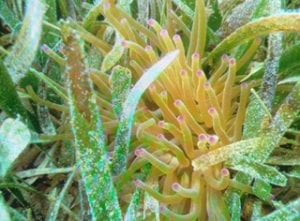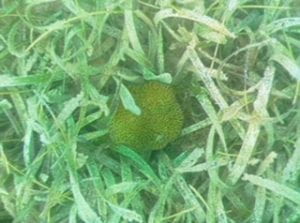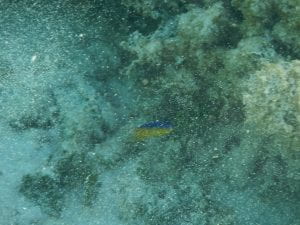The McKenna that is writing this post is a completely different person than the McKenna that wrote the previous blogs. Today, I saw coral reefs with my very own eyes, and it was such a life-changing experience!
The day started early with breakfast at 7:00 am. We wasted no time getting into the water, and we swam to path reefs close by the Glover’s dock. I was surprised by how much sediments can make snorkeling an issue; one kick downward with your fin and all of the scenery around you is made barely visible. Needless to say, I quickly learned to stay on my stomach. At the patch reefs, I saw so many amazing things, notably a baby lionfish and a pufferfish. On the way back, I saw a Great Caribbean anemone in a bed of seagrass! (Please forgive that this is a photo taken of a digital picture)
After getting back, we made reef supplies for future endeavors, including an expertly-woven quadrant and a top-of-the-line snorkel clipboard with waterproof paper!
After lunch, we suited back up and sprinted (I’m not kidding, we actually sprinted there to avoid the swarm of mosquitos) to explore the mangrove of death (oooo aaahh). We brought our clipboards with us to do a scavenger hunt! Liliana and I were buddies, and we found lots of cool things, like a sea cucumber and a Christmas tree worm. We decided to swim back because the mosquitos were that bad, and that is when I spotted a warty corallimorph! This is usually a solitary organism, so it was all by itself. (Again, photo of a photo)
The mangrove snorkel was amazing! Afterward, we ate dinner and gave presentations.
Today was incredible. I am so excited for the upcoming reef days to explore more! Another night of needed rest awaits me. A TFB always needs their beauty sleep 🙂
– McKenna




